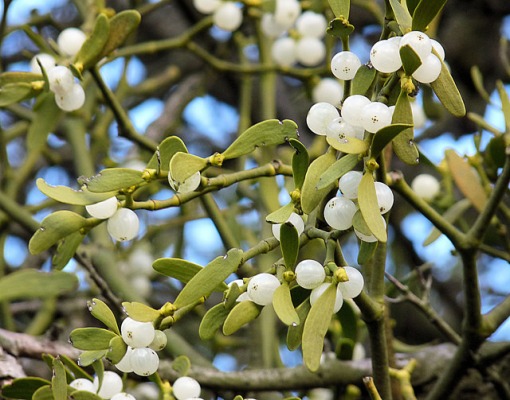
This plant for love birds is a parasite. Food for thought. Photo by Hornet Photography. Mistletoe-Viscum album. CC. https://flic.kr/p/jKt9Kz
In this season of holiday parties and festive family gatherings, let’s take a look at the plant we smooch under in December and then forget for the rest of the year: mistletoe.
Mistletoe is not holly
It’s a common mistake. Hollies are evergreen trees with spiky leaves and red berries. Mistletoe is an evergreen with smooth oval leaves and white berries. It is also a parasite that hangs out in tree branches.
Stuck on you
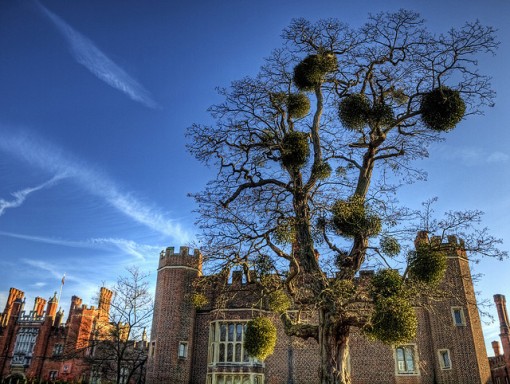
Mistletoe doing its parasitic thing. Photo by Neil Howard. Tree with Mistletoe-Hampton Court Palace. CC. https://flic.kr/p/7rSpe4
Mistletoe steals food from the tree it lives on. The mistletoe seed latches onto a tree branch and penetrates the bark with its roots. Then it slurps up the tree’s hard-won water and minerals like drinking a bottomless milkshake.
Not only do mistletoe plants have a good view up in the tree, they also get a lot of light. They use this light to make food of their own through photosynthesis.
Some mistletoe species even parasitize other mistletoes. Nature is strange.
All in the family
The mistletoe family, Loranthaceae, has over 1000 species. Most species are tropical. The one we kiss under, Viscum album, grows in temperate Europe, Asia and Africa. Viscum album prefers to grow on commercially valuable trees like apple, oak, poplar and hawthorn.
What do witches’ brooms have to do with Christmas?
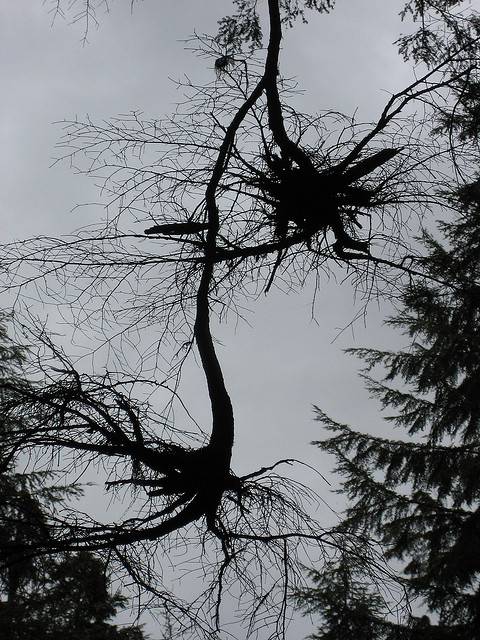
Trees have some strange responses to mistletoe infection, like developing these gnarled branches. Photo by Nick Bonzey. Witch’s broom. CC. https://flic.kr/p/2jXZ1z
Mistletoe grows very slowly. Viscum album only gets to be about 2-3 feet tall. Mistletoe is almost immortal. It only dies if the host dies. Or if a tree farmer yanks them out with a pole.
Tree farmers are not big mistletoe fans. Severe mistletoe infestations can drain a tree’s resources. Instead of growing taller or producing more apples, the trees spend their energy feeding the mistletoe.
Trees sometimes try to fight back against the mistletoe by growing several branches around it. These branches are often deformed, and are called ‘witches’ brooms.’ Unfortunately, these witches’ brooms suck the tree’s resources even more. If the tree dies, the witches’ broom is often the last part to go.
It’s not all bad though. Birds love to make nests in witches’ brooms. But, then again, birds are also a mistletoe’s best friend.
The dung plant
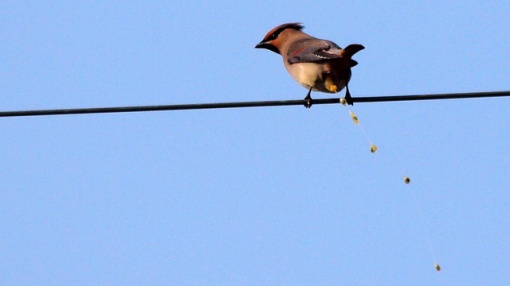
One way that mistletoe seeds get around. Photo by coniferconifer. Dispersing Mistletoe seeds by Japanese Waxwing. CC. https://flic.kr/p/kW7zJF
How on earth does this air-borne plant make sure its seeds get stuck on tree branches? The answer has two wings and a beak.
Remember those white berries? Each one is full of sticky pulp and a single seed. The pulp is toxic to humans and animals, but not to birds. After guzzling the berries, birds will scrape their beaks against tree bark to remove the sticky pulp. Any seeds that gets scraped onto the bark now have a new home to parasitize.
Birds also poop in trees and spread the seeds that way. This is where mistletoe got its name. Mistel is an old Anglo-Saxon word for dung. Something to think about while smooching under this fabled plant.
The weird Canadian cousin
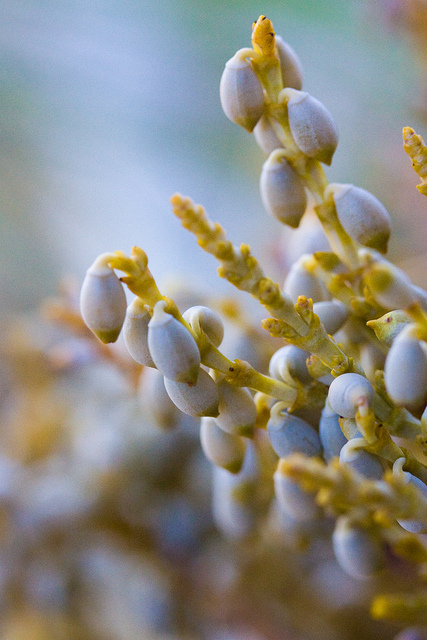
Canada has tiny mistletoe that grows on conifers, of course. Photo by Ken-ichi Ueda. Bad Seed. CC. https://flic.kr/p/8Jr92s
The mistletoe of holiday traditions is very European, but Canada has some too. Four species, to be exact. In the true Canadian way, they parasitize pine trees.
They belong to a group called Dwarf mistletoe. These itty-bitty plants have 3mm branches and 4mm berries. They have done away with leaves, and have scales instead.
Arguably the coolest thing about dwarf mistletoe is that they spread their seeds by shooting them onto a neighboring branch. As the fruit ripens, pressure builds up until KABOOM! The fruit explodes and the seeds fly out at high speed. If these sticky bullets are lucky, they’ll hit a branch and stick there.
I could see why this isn’t a popular plant to kiss under. Sticky seeds in your up-do simply isn’t sexy.
Mythic origins
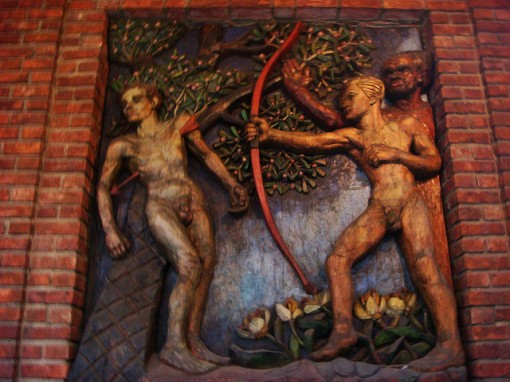
Mistletoe is part of a dastardly deed in Norse mythology. Photo by Don Meliton. The death of Balder. CC. https://flic.kr/p/3QsKqv
Okay, so why do we kiss under these parasitic ‘dung’ plants in the first place?
The mistletoe’s story begins in Celtic Europe. Its evergreen leaves were seen as a symbol of magical power and rebirth, especially during the winter when mistletoe is one the only green things around. Druids used mistletoe in religious ceremonies as a cure-all and to bring good luck.
The mistletoe was also significant in German and Norse mythology, especially when it grew on sacred oak trees. Mistletoe was believed to bring happiness, safety and good luck, as long as it didn’t touch the ground.
Mistletoe plays a starring role in the Norse myth of Baldur’s murder. Baldur was immortal because his mother made everything on earth promise not to hurt him. Some would call that helicopter parenting. She missed the mistletoe, because what could it do? Shoot berries at him?
But Loki, the trickster, made a spear out of mistletoe and tricked another god into killing Baldur with it. Some myths say the mistletoe’s white berries are his mother’s tears. Others say that the gods decided that after this tragic event the mistletoe would bring love instead of death.
As a result, when Scandinavian warriors met an enemy under a mistletoe, it was customary to lay down their weapons for the day. It’s a far cry from kissing, but not killing each other is the first step.
Norse mythology and traditions were adopted by the French and English, who started using mistletoe as a holiday decoration.

Modern-day mistletoe tradition. Photo by Will Folsom. Mistletoe. CC. https://flic.kr/p/b1cZYH
Reportedly the kissing thing finally happened in England, and was later imported to North America. In some circles kissing under a mistletoe was thought to always lead to marriage, so you had to be careful who you kissed!
Special powers
In Celtic traditions mistletoe was a cure-all. Some groups in Europe used it as an aphrodisiac and to boost fertility. Confusingly, others used it as a contraceptive.
Remember those dwarf mistletoe in Canada? Some indigenous groups in western Canada boiled and ate the berries. They also made a contraceptive tea out of the scaly leaves.
Beliefs about mistletoe’s healing powers continue to this day. Since 1916 mistletoe has been used as an alternative cancer treatment. The poisonous chemicals in the berries were thought to stimulate the immune system and help it fight off cancer.
No clinical trials have proven that mistletoe can cure cancer. That doesn’t change the fact that it is one of the most widely used unconventional cancer treatments in Europe.
There you have it, some interesting facts about mistletoe to share at your next holiday party. See if you can spot any in the trees this winter.
References
http://www.britannica.com/EBchecked/topic/257150/haustorium
http://www.britannica.com/EBchecked/topic/385828/mistletoe
http://www.britannica.com/EBchecked/topic/174870/dwarf-mistletoe
http://kids.britannica.com/comptons/article-9275872/mistletoe
http://www.thecanadianencyclopedia.ca/en/article/mistletoe/
http://thisisafrica.me/trevor-noah-turns-african-stereotypes-america/
http://okeechobee.ifas.ufl.edu/News%20columns/Mistletoe.htm
http://nassau.ifas.ufl.edu/horticulture/gardentalk/pests.html#mistletoe
http://okeechobee.ifas.ufl.edu/News%20columns/Holly.Holidays.htm
http://www.apsnet.org/edcenter/intropp/lessons/miscellaneous/Pages/Dwarfmistletoes.aspx
(lots of good photos)

